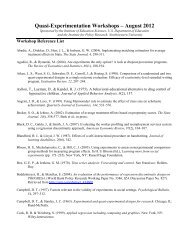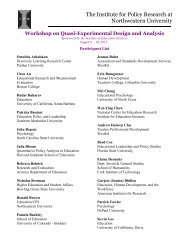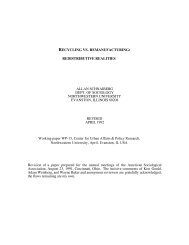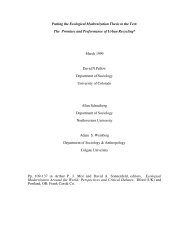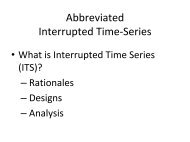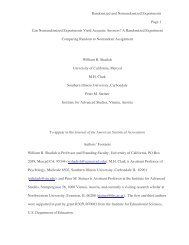Whatever Happened to the Emerging Democratic Majority?
Whatever Happened to the Emerging Democratic Majority?
Whatever Happened to the Emerging Democratic Majority?
Create successful ePaper yourself
Turn your PDF publications into a flip-book with our unique Google optimized e-Paper software.
I L L I N O I S<br />
FAMILIES<br />
S T U D Y<br />
IFS Policy Brief<br />
No. 9 September 2005<br />
Who Gets Ahead? Work Profiles of Former Welfare<br />
Recipients in Illinois<br />
Dan A. Lewis, Emily Collins, and Laura B. Amsden<br />
Illinois has passed <strong>the</strong> seven-year mark on <strong>the</strong> major welfare<br />
reforms that were signed in<strong>to</strong> law in 1996 and implemented in<br />
<strong>the</strong> state in 1997. The law’s “work first” philosophy emphasized<br />
labor force participation as a panacea for welfare dependency,<br />
although previous Illinois Families Study (IFS) reports have<br />
shown that close <strong>to</strong> half of IFS respondents who left welfare<br />
do not regularly participate in <strong>the</strong> labor force. Now that <strong>the</strong><br />
initial enthusiasm over welfare reform has died down, how have<br />
individuals and families been affected by <strong>the</strong> policy changes?<br />
Drawing upon IFS results collected between 1999 and 2003,<br />
this policy brief reveals a sobering picture of those who work<br />
and <strong>the</strong>ir job type.<br />
Responses from 1999-00 <strong>to</strong> 2003 show steady proportions<br />
of working respondents and sharp declines in Temporary<br />
Assistance for Needy Families (TANF) use. The percentage of<br />
respondents working across all four survey years held steady<br />
at approximately 50 percent while <strong>the</strong> proportion receiving<br />
TANF dropped from 53 percent <strong>to</strong> 11 percent.<br />
Approximately 70 percent of<br />
respondents received no type of<br />
employer benefit in 2003, with only<br />
30 percent receiving employersponsored<br />
health insurance.<br />
Of <strong>the</strong> 50 percent of IFS respondents working in 2003,<br />
<strong>the</strong> majority held jobs in <strong>the</strong> occupations of personal care,<br />
administrative support, sales, and health care support (see Table<br />
1). The <strong>to</strong>p four industries where <strong>the</strong> majority of respondents<br />
worked were health care and social assistance, educational<br />
services, accommodations and food service, and retail trade<br />
(see Table 2).<br />
While employed respondents made gains in hourly wages<br />
across all occupations and industries, <strong>the</strong> average amount<br />
earned per hour remained relatively low. Across <strong>the</strong> <strong>to</strong>p four<br />
occupations, <strong>the</strong> average hourly wage was $9.44, up from $7.61<br />
in 1999-00. Across <strong>the</strong> <strong>to</strong>p four industries, <strong>the</strong> average hourly<br />
wage was $8.94, up from $7.06 in 1999-00.<br />
Although <strong>the</strong> proportion of respondents receiving employersponsored<br />
benefi ts increased over <strong>the</strong> years of <strong>the</strong> study,<br />
approximately 70 percent of respondents received no type of<br />
employer benefit, with only 30 percent of working respondents<br />
(continued on page 20)<br />
Table 1: Current Occupation<br />
2003<br />
(n=462)<br />
Personal care and service 23.2%<br />
Offi ce and administrative support 17.4%<br />
Sales and related occupations 11.2%<br />
Health care support 10.8%<br />
Education, training, and library 5.7%<br />
Building/grounds cleaning and<br />
maintenance 4.8%<br />
Management 4.5%<br />
Food preparation and service related 4.4%<br />
Protective service 4.0%<br />
Production 3.8%<br />
O<strong>the</strong>r 10.0%<br />
Table 2: Current Industry<br />
2003<br />
(n=462)<br />
Health care and social assistance 38.0%<br />
Educational services 12.5%<br />
Accommodations and food service 9.5%<br />
Retail trade 9.1%<br />
Transportation and warehousing 5.4%<br />
Management, administrative and<br />
support, and waste management 5.3%<br />
Manufacturing 3.5%<br />
Finance and insurance 2.5%<br />
O<strong>the</strong>r 14.3%<br />
The IFS asks respondents who are working about <strong>the</strong>ir current<br />
employment occupation and industry. Occupation responses<br />
were coded according <strong>to</strong> <strong>the</strong> 2000 Standard Occupational<br />
Classifi cation System and industry responses according <strong>to</strong><br />
<strong>the</strong> 1997 North American Industry Classifi cation System<br />
from <strong>the</strong> U.S. Census Bureau. Web site: http://www.census.<br />
gov/hhes/www/ioindex/view.html






